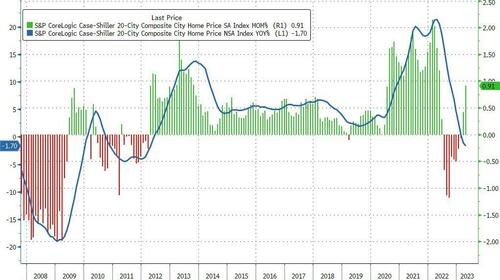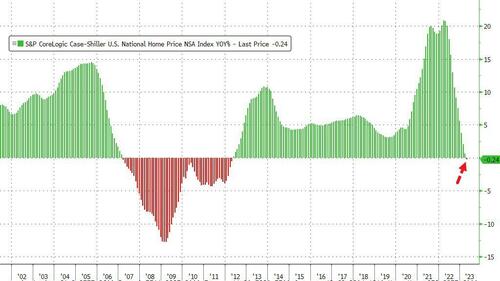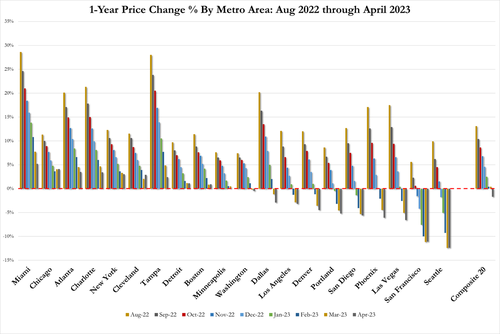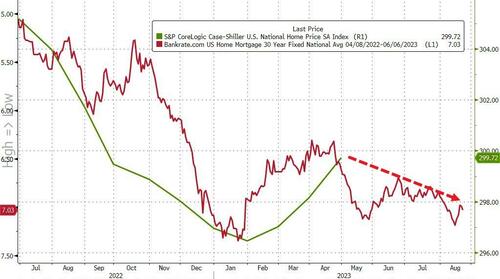US Home Prices Surged In April; All 20 Cities See Gains As Rates Dipped
Having bounced (unexpectedly) in March (the most recent data), Case-Shiller’s 20-City Composite home price index was expected to continue bouncing in April (+0.4% MoM exp) and it did bigly – rising 0.91% MoM – the biggest MoM jump since May 2022…

Source: Bloomberg
Home prices peaked in June 2022, declined until January 2023, and then began to recover. The National Composite rose by 1.3% in April (repeating March’s performance), and now stands only 2.4% below its June 2022 peak. Our 10- and 20-City Composites both gained 1.7% in April.
“The U.S. housing market continued to strengthen in April 2023,” says Craig J. Lazzara, Managing Director at S&P DJI.
However, the National Home Price Index (NSA) turned down on a YoY basis for the first time since April 2012…

Source: Bloomberg
The ongoing recovery in home prices is broadly based. Before seasonal adjustments, prices rose in all 20 cities in April (as they had also done in March). Seasonally adjusted data showed rising prices in 19 cities in April (versus 14 in March).
On a trailing 12-month basis, the National Composite is 0.2% below its April 2022 level, with the 10- and 20-City Composites also negative on a year-over-year basis, but regional differences continue to be striking.
Miami’s 5.2% gain made it the best-performing city for the ninth consecutive month, but in April Chicago toddled into second place with a 4.1% gain. Atlanta (+3.5%) and Charlotte (+3.4%) round out the top four.
The next three positions are occupied by New York, Cleveland, and then perennial medalist Tampa, indicating a remarkable diversity among the top performers.
At the other end of the scale, however, the worst eight performers are all in the Mountain or Pacific time zones, with Seattle (-12.4%) and San Francisco (-11.1%) at the bottom. The Southeast (+3.6%) continues as the country’s strongest region, while the West (-6.9%) remains the weakest.

Notably the bounce in the highly-lagged Case-Shiller home price data occurred as mortgage rates eased lower. They are now back near recent cycle highs – above 7.00%…

Source: Bloomberg
Lazarra adds:
“If I were trying to make a case that the decline in home prices that began in June 2022 had definitively ended in January 2023, April’s data would bolster my argument. Whether we see further support for that view in coming months will depend on the how well the market navigates the challenges posed by current mortgage rates and the continuing possibility of economic weakness.”
Finally, as a reminder, the man behind the home price index – Yale economist Bob Shiller – told CNBC’s “Closing Bell: Overtime” last month that “home prices are very, very high by historical standards.”
“I would extrapolate the downturn somewhat – it’s going to continue,” he added.
“Maybe if you have a good chance to delay your purchase, it might be a good time to do it.”
“It might get a little cheaper after another six months.”
This is certainly not the ‘normalization’ that The Fed is looking for from its aggressive tightening.
Loading…
[ad_2]
Source link


